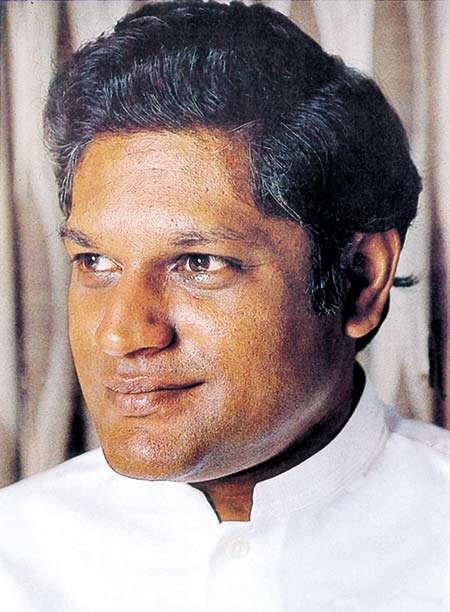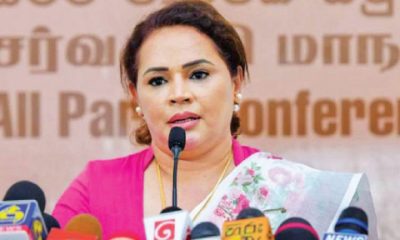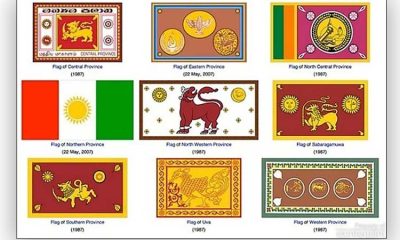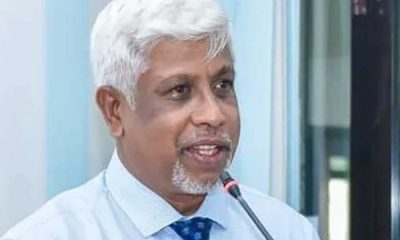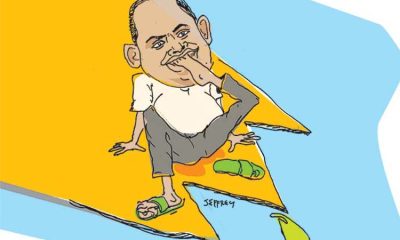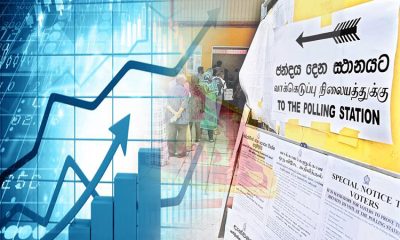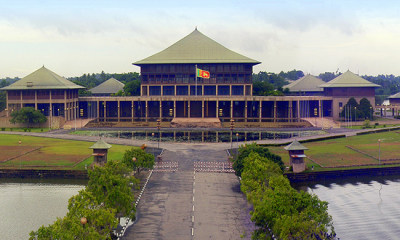Features
Upali Wijewardene – an enigma and a legend
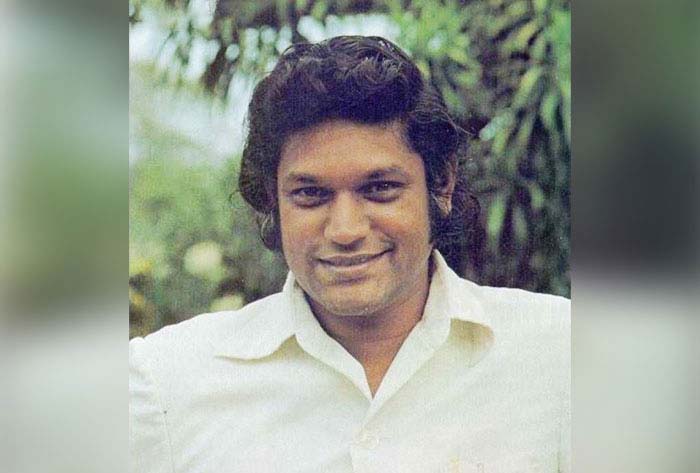
by Ajith Samaranayake
Between Sri Lanka’s 35th independence anniversary and his birthday Upali Wijewardene boarded his executive Lear Jet at Kuala Lumpur and in a single fateful flash became solidified into an enigma and a legend. The flamboyant tycoon who had left with five others never arrived in Colombo. Somewhere over the Straits of Malacca the plane disappeared with not a clue or a trace.
The drama held the nation in its grip for months. Newspapers reported little else except the mystery of the disappearance. Speculation spread like a bush fire and as the days passed with no news the most fantastic cloak and dagger theories were spun. People gathered by the roadside to listen to the radio news bulletins and strangers become friends as they speculated about the fate of a man who was one of Sri Lanka’s most beloved sons.
Destined
For Philip Upali Wijewardene it was a strangely fitting apotheosis. It was as if his whole colourful career was destined for this final peak, this sudden and dramatic exit just as he was in the very centre of the public eye, a glorious accession to the heights of myth and legend.
For Upali’s life was of the kind which dreams are made of. Though born to one of the most distinguished families in Colombo and into a charmed circle which constituted Sri Lanka’s ruling elite, Upali had carved out a career in an area totally out of synch with that class. He did not take to law or medicine or pursue an academic career as the more favoured sons of this affluent, anglicised and genteel elite were wont to do. Neither did he take to politics.
On the contrary with nothing much except the most rudimentary capital and confidence in his own abilities he began a confectionery industry and business in a part of his ancestral home where such brushes with crude commerce had never before taken place. Down the years this fledgling business he was able to build and expand into a mighty conglomerate, Sri Lanka’s only multinational, until he acquired a worldwide reputation as Sri Lanka’s leading entrepreneur, an enterprising and shrewd businessman who could hold his own with the best of them in New York, London or Bonn.
But by February 13, that fateful day which again confirmed the hold of superstition, Upali’s mind was not preoccupied with his businesses alone. For about two years politics had replaced business as his central passion. The man who had conquered the commanding heights of commerce now wanted to conquer the commanding heights of politics. And like everything else he did, he wanted to do it soon.
In 1981 he had founded The Island and the Divaina which had immediately become the eye of the political storm. Their vigorous reporting and comments which did not spare even some of the most powerful politicians of the ruling UNP came as a stirring antidote to the flabby, tame-cat Lake House press which was then dominating journalism.
Readers lapped up the new offerings avidly. Upali Wijewardene’s name was bandied about freely in Parliament. He made no secret of the fact that he wanted to enter Parliament and become finance minister which raised the hackles of the Finance Minister, the fiercely combative Mr. Ronnie de Mel. It became quite commonplace for the bespectacled and owlish Minister to hurl fearsome thunderbolts at the absent Upali in Parliament while we parliamentary reporters of The Island in the absence of our owner became surrogates for the ministerial fury and the embarrassed focus of the eyes of our colleagues in the crowded press gallery of the old Parliament by the sea.
Following year
The following year was to be one of the most crucial in Sri Lanka’s politics. President Jayewardene, Upali’s cousin and mentor, called an early Presidential Election, and in the absence of his normal rival Mrs. Sirima Bandaranaike, incapacitated by her loss of civic rights, easily beat former Minister Hector Kobbekoduwa fielded by an SLFP in tatters.
Then claiming that there was a Naxalite conspiracy to assassinate him if he had lost and claiming further that if General Elections were held on schedule a sizeable number of these horrendous Naxalites would enter Parliament he held a Referendum which the UNP won amidst widespread claims of thuggery, ballot-rigging, etc.
Anyway Upali was loyally by Jayewardene’s side during both campaigns, campaigning vigorously for the UNP at Kamburupitiya, his mother’s ancestral village, for which he had done much through his Ruhunu Udanaya programme for improving the conditions of villages in the South. The south he considered his heartland and it was from the South that he sought to enter Parliament for which there were vacancies even as he boarded his Lear Jet that day in the Malaysian capital.
Elections
For what had happened was that Jayewardene had asked for and received the resignations of 17 members of Parliament who had lost their electorates at the Referendum. Parliament had just been convened for the new session of the Second Jayewardene Presidency and the guns had boomed and the Jayamangala Gathas had been chanted. As that irrepressible Communist MP, the much lamented late Sarath Muttettuwegama quipped, “There was a 21-gun salute only the other day. And now 17 of you are gone.” Among the vacancies were Kamburupitiya and Devinuwara either of which Upali was planning to contest.
This was the backdrop to Upali’s destiny which during the next few weeks would hold the nation in its grip and virtually bring the country to a standstill. Among those on board with Upali in the plane which had left Malaysia’s Subang Airport at 8.41 p.m. on February 13 were Mr. Ananda Pelimuhandiram, the whiz kid Financial Director of the Upali Group and one of his most trusted lieutenants, a Malaysian lawyer Mr. S. M. Ratnam and Steward Mr. A. Senanayake. The jet was piloted by Capt. Noel Anandappa with Mr. Sidney de Zoysa as co-pilot.
They were to have reached Colombo by 9.45 p.m. that night but they did not come. Neither did they come the next day. By the morning of Monday February 14 Colombo was agog with the news. Soon it spread everywhere and the people paused in awe and wonderment as the enormity of the event sank into the public consciousness. Upali Wijewardene had mysteriously vanished with his three companions and two navigators leaving not a clue behind somewhere in that vast and empty night sky over Malaysia.
On Tuesday February 15 The Island, ‘Upali’s beloved flagship, broke the news soberly. Over a banner headline “Plane carrying Upali Wijewardene feared lost”. it told its readers that the jet had lost radio contact with the airport just 15 minutes after take off. The last message had said that the aircraft was at an altitude of 27,000 feet. Indonesia and Malaysia had launched a joint air and sea search operation but had failed to find any debris of an aircraft.
At The Island that Monday it was like something out of a novel by Kafka. We were in a daze. Was it possible that six people on board an aircraft in this miraculous age of technology could disappear without a trace? People huddled about the corridors talking, absorbing the news only slowly while the telephones rang incessantly as the other newspapers were getting in touch with us for the latest. But we could do little to shed light on the mystery. The most intensive search by several governments could not yield a single clue. These headlines from the papers which followed convey the flavour of those bizarre days.
February 16 —Air, sea search for Upali Wijewardene continues. Aussie plane may have seen missing jet
February 17— Three planes with sophisticated equipment comb the ocean. No results yet from seven-notion search
A flare and a weak signal but search proves negative. Search for missing plane in Andaman Island.
February 18 – Search for missing jet narrows to coastal area round Sumatra. Lear Jet reps suspect sabotage.
Wreckage
On the same day something happened which could well have been the tragic denouement of the whole drama but which was aborted at the last moment. On the afternoon of that Friday a Reuter report was received that the wreckage of the private jet and several bodies had been found off the Indonesian island of Sumatra.
I was in Fort at the time having taken a brief respite from the bleak house at Bloemendhal Road. With me at one of Fort’s many hospitable hostelries where we were drinking more than usual was Joe Segera, the Daymon Runyonesque Lake House story teller and chronicler of Canal Row and Chandra S. Perera, the always nattily-dressed NBC reporter and man about town.
Slowly the story spread through Canal Row, Hospital Street and Baillie Street and people reacted with shock and grief. More pints were drunk and our senses numbed somewhat by what we had taken Chandra who had known Upali in London and had common friends with him and I repaired to Bloemendhal Road.
There we were told by Editor Vijitha Yapa who had worked frenziedly during those days to bring out the paper in the midst of the tension that Reuter had denied the story within the hour. The next day The Island reported that it had been besieged with telephone calls following the story breaking. Reuters, Hong Kong had been contacted and The Island told ‘The story will be held back’, it reported.
And so the days passed. More headlines.
February 19 — Divers too join search near Sumatra. Another frustrating day of search
February 21 — Top Sri Lanka cops arrive in KL for investigation
Sabotage not ruled out
February 22 — Wheel found by fishermen did come from Lear Jet. Oil slick found near Kumana not from Lear Jet. February 23 —Minesweepers deployed in Indonesia today to find Jet Identification of Lear Jet wheel narrows search area. February 24 — If Lear Jet wheel was spare explosion may have occurred
February 25 —Fishermen cleared: Minesweeper move into find jet. There was no black box on missing Lear Jet. February 26 — PM answers questions on Upali
Unsolved
And so that unusually short month petered out sadly with the riddle unsolved. On the last day of February The Island headline was ‘Lalith thinks sabotage is likely cause of crash’. Under the by line of Lasantha Wickremetunge it said that the then Minister of Trade and Shipping Lalith Athulathmudali who had returned from Indonesia on February 26 as President Jayewardene’s special envoy had said that there were three possibilities for the disappearance of which the most likely was sabotage. Of the other possibilities, pilot error and a defect in the aircraft were most unlikely.
Mr. Athulathmudali also stressed that his investigations had shown that Mr. Wijewardene had no commercial enemies. In a box in the same story the paper reported ‘Temporary halt to search’ saying that since the area searched by the minesweeper had yielded no clues the search; was being abandoned and would resume if fresh evidence is uncovered. Only a single wheel — the right outbourne wheel — of the whole aircraft was found.
And so ended a drama which had electrified the country that cruel month of February and still continues to bemuse the people. What happened to Upali? is still the most popular question asked by friends and acquaintances from anybody connected with the Upali Group. Upali fascinated the people in life and now that he is no longer to be found, lost somewhere in the vast ethereal emptiness, he has become a legend and a cult which continues to enthral the people.
What would have happened if he had arrived in Colombo that February night with politics entering a fresh phase and plunged into what would have undoubtedly been a stormy political career will remain one of the most fascinating “Ifs”, of our contemporary political history.
Enigmatic fate
But what is clear is that the enigmatic fate of the man who built a commercial empire from nothing and captured a nation’s heart will always be looked upon with wonderment by them. Whether Upali could have stormed the commanding heights of politics by using the methods of advertising and self-promotion which he so successfully used in his business enterprises we will never know. Yet, like Icarus who flew but went too close to the sun so that his wings melted, the strange and fascinating destiny of Upali Wijewardene, Sri Lanka’s first tycoon who also chose the sun as his symbol, will always be a glorious legend of our times.
Newspaper
Looking back across ten more eventful years several memories crowd the mind. The memory which stands out most prominently is that of the collective effort to bring out the paper in the midst of the most terrible tension which could have pervaded any newspaper office. Editor Vijitha Yapa who was a loyal friend of Upali had to battle his feelings while he held the fort in the news room keeping in constant touch with the latest developments and answering the questions of local and foreign journalists.
For him and Deputy Editor and News Editor Gamini Weerakoon it was a trial of endurance which they magnificently stood up to. Looking at the paper to which thousands turned during that fateful month for news of its proprietor there is no sign of the almost unbearable tension with which we were working.
Upali Mahattaya
Several days on end we did not go home and the bleak reaches of the night were spent on the bare office tables with the late K. C. Kulasinghe as my companion. Or some nights would be spent in the grimy digs of D. B. S. Jeyaraj located quite close to the Premil Sports Club which was often the hub of our social life where the owner, the late Rajendra Mudalali, would approach us sombrely, always dressed in spotless white sarong and shirt and inquire ‘Any news of Upali Mahattaya?’ And in the morning the sun would rise over the splendid dome of St. Lucia’s Cathedral and we would search the vast sky for an answer.
(This article first appeared in a supplement to mark the 10th anniversary of the disappearance of Upali Wijewardene and party on Feb 13, 1993)
Features
The heart-friendly health minister

by Dr Gotabhya Ranasinghe
Senior Consultant Cardiologist
National Hospital Sri Lanka
When we sought a meeting with Hon Dr. Ramesh Pathirana, Minister of Health, he graciously cleared his busy schedule to accommodate us. Renowned for his attentive listening and deep understanding, Minister Pathirana is dedicated to advancing the health sector. His openness and transparency exemplify the qualities of an exemplary politician and minister.
Dr. Palitha Mahipala, the current Health Secretary, demonstrates both commendable enthusiasm and unwavering support. This combination of attributes makes him a highly compatible colleague for the esteemed Minister of Health.
Our discussion centered on a project that has been in the works for the past 30 years, one that no other minister had managed to advance.
Minister Pathirana, however, recognized the project’s significance and its potential to revolutionize care for heart patients.
The project involves the construction of a state-of-the-art facility at the premises of the National Hospital Colombo. The project’s location within the premises of the National Hospital underscores its importance and relevance to the healthcare infrastructure of the nation.
This facility will include a cardiology building and a tertiary care center, equipped with the latest technology to handle and treat all types of heart-related conditions and surgeries.
Securing funding was a major milestone for this initiative. Minister Pathirana successfully obtained approval for a $40 billion loan from the Asian Development Bank. With the funding in place, the foundation stone is scheduled to be laid in September this year, and construction will begin in January 2025.
This project guarantees a consistent and uninterrupted supply of stents and related medications for heart patients. As a result, patients will have timely access to essential medical supplies during their treatment and recovery. By securing these critical resources, the project aims to enhance patient outcomes, minimize treatment delays, and maintain the highest standards of cardiac care.
Upon its fruition, this monumental building will serve as a beacon of hope and healing, symbolizing the unwavering dedication to improving patient outcomes and fostering a healthier society.We anticipate a future marked by significant progress and positive outcomes in Sri Lanka’s cardiovascular treatment landscape within the foreseeable timeframe.
Features
A LOVING TRIBUTE TO JESUIT FR. ALOYSIUS PIERIS ON HIS 90th BIRTHDAY

by Fr. Emmanuel Fernando, OMI
Jesuit Fr. Aloysius Pieris (affectionately called Fr. Aloy) celebrated his 90th birthday on April 9, 2024 and I, as the editor of our Oblate Journal, THE MISSIONARY OBLATE had gone to press by that time. Immediately I decided to publish an article, appreciating the untiring selfless services he continues to offer for inter-Faith dialogue, the renewal of the Catholic Church, his concern for the poor and the suffering Sri Lankan masses and to me, the present writer.
It was in 1988, when I was appointed Director of the Oblate Scholastics at Ampitiya by the then Oblate Provincial Fr. Anselm Silva, that I came to know Fr. Aloy more closely. Knowing well his expertise in matters spiritual, theological, Indological and pastoral, and with the collaborative spirit of my companion-formators, our Oblate Scholastics were sent to Tulana, the Research and Encounter Centre, Kelaniya, of which he is the Founder-Director, for ‘exposure-programmes’ on matters spiritual, biblical, theological and pastoral. Some of these dimensions according to my view and that of my companion-formators, were not available at the National Seminary, Ampitiya.
Ever since that time, our Oblate formators/ accompaniers at the Oblate Scholasticate, Ampitiya , have continued to send our Oblate Scholastics to Tulana Centre for deepening their insights and convictions regarding matters needed to serve the people in today’s context. Fr. Aloy also had tried very enthusiastically with the Oblate team headed by Frs. Oswald Firth and Clement Waidyasekara to begin a Theologate, directed by the Religious Congregations in Sri Lanka, for the contextual formation/ accompaniment of their members. It should very well be a desired goal of the Leaders / Provincials of the Religious Congregations.
Besides being a formator/accompanier at the Oblate Scholasticate, I was entrusted also with the task of editing and publishing our Oblate journal, ‘The Missionary Oblate’. To maintain the quality of the journal I continue to depend on Fr. Aloy for his thought-provoking and stimulating articles on Biblical Spirituality, Biblical Theology and Ecclesiology. I am very grateful to him for his generous assistance. Of late, his writings on renewal of the Church, initiated by Pope St. John XX111 and continued by Pope Francis through the Synodal path, published in our Oblate journal, enable our readers to focus their attention also on the needed renewal in the Catholic Church in Sri Lanka. Fr. Aloy appreciated very much the Synodal path adopted by the Jesuit Pope Francis for the renewal of the Church, rooted very much on prayerful discernment. In my Religious and presbyteral life, Fr.Aloy continues to be my spiritual animator / guide and ongoing formator / acccompanier.
Fr. Aloysius Pieris, BA Hons (Lond), LPh (SHC, India), STL (PFT, Naples), PhD (SLU/VC), ThD (Tilburg), D.Ltt (KU), has been one of the eminent Asian theologians well recognized internationally and one who has lectured and held visiting chairs in many universities both in the West and in the East. Many members of Religious Congregations from Asian countries have benefited from his lectures and guidance in the East Asian Pastoral Institute (EAPI) in Manila, Philippines. He had been a Theologian consulted by the Federation of Asian Bishops’ Conferences for many years. During his professorship at the Gregorian University in Rome, he was called to be a member of a special group of advisers on other religions consulted by Pope Paul VI.
Fr. Aloy is the author of more than 30 books and well over 500 Research Papers. Some of his books and articles have been translated and published in several countries. Among those books, one can find the following: 1) The Genesis of an Asian Theology of Liberation (An Autobiographical Excursus on the Art of Theologising in Asia, 2) An Asian Theology of Liberation, 3) Providential Timeliness of Vatican 11 (a long-overdue halt to a scandalous millennium, 4) Give Vatican 11 a chance, 5) Leadership in the Church, 6) Relishing our faith in working for justice (Themes for study and discussion), 7) A Message meant mainly, not exclusively for Jesuits (Background information necessary for helping Francis renew the Church), 8) Lent in Lanka (Reflections and Resolutions, 9) Love meets wisdom (A Christian Experience of Buddhism, 10) Fire and Water 11) God’s Reign for God’s poor, 12) Our Unhiddden Agenda (How we Jesuits work, pray and form our men). He is also the Editor of two journals, Vagdevi, Journal of Religious Reflection and Dialogue, New Series.
Fr. Aloy has a BA in Pali and Sanskrit from the University of London and a Ph.D in Buddhist Philosophy from the University of Sri Lankan, Vidyodaya Campus. On Nov. 23, 2019, he was awarded the prestigious honorary Doctorate of Literature (D.Litt) by the Chancellor of the University of Kelaniya, the Most Venerable Welamitiyawe Dharmakirthi Sri Kusala Dhamma Thera.
Fr. Aloy continues to be a promoter of Gospel values and virtues. Justice as a constitutive dimension of love and social concern for the downtrodden masses are very much noted in his life and work. He had very much appreciated the commitment of the late Fr. Joseph (Joe) Fernando, the National Director of the Social and Economic Centre (SEDEC) for the poor.
In Sri Lanka, a few religious Congregations – the Good Shepherd Sisters, the Christian Brothers, the Marist Brothers and the Oblates – have invited him to animate their members especially during their Provincial Congresses, Chapters and International Conferences. The mainline Christian Churches also have sought his advice and followed his seminars. I, for one, regret very much, that the Sri Lankan authorities of the Catholic Church –today’s Hierarchy—- have not sought Fr.
Aloy’s expertise for the renewal of the Catholic Church in Sri Lanka and thus have not benefited from the immense store of wisdom and insight that he can offer to our local Church while the Sri Lankan bishops who governed the Catholic church in the immediate aftermath of the Second Vatican Council (Edmund Fernando OMI, Anthony de Saram, Leo Nanayakkara OSB, Frank Marcus Fernando, Paul Perera,) visited him and consulted him on many matters. Among the Tamil Bishops, Bishop Rayappu Joseph was keeping close contact with him and Bishop J. Deogupillai hosted him and his team visiting him after the horrible Black July massacre of Tamils.
Features
A fairy tale, success or debacle

Sri Lanka-Singapore Free Trade Agreement
By Gomi Senadhira
senadhiragomi@gmail.com
“You might tell fairy tales, but the progress of a country cannot be achieved through such narratives. A country cannot be developed by making false promises. The country moved backward because of the electoral promises made by political parties throughout time. We have witnessed that the ultimate result of this is the country becoming bankrupt. Unfortunately, many segments of the population have not come to realize this yet.” – President Ranil Wickremesinghe, 2024 Budget speech
Any Sri Lankan would agree with the above words of President Wickremesinghe on the false promises our politicians and officials make and the fairy tales they narrate which bankrupted this country. So, to understand this, let’s look at one such fairy tale with lots of false promises; Ranil Wickremesinghe’s greatest achievement in the area of international trade and investment promotion during the Yahapalana period, Sri Lanka-Singapore Free Trade Agreement (SLSFTA).
It is appropriate and timely to do it now as Finance Minister Wickremesinghe has just presented to parliament a bill on the National Policy on Economic Transformation which includes the establishment of an Office for International Trade and the Sri Lanka Institute of Economics and International Trade.
Was SLSFTA a “Cleverly negotiated Free Trade Agreement” as stated by the (former) Minister of Development Strategies and International Trade Malik Samarawickrama during the Parliamentary Debate on the SLSFTA in July 2018, or a colossal blunder covered up with lies, false promises, and fairy tales? After SLSFTA was signed there were a number of fairy tales published on this agreement by the Ministry of Development Strategies and International, Institute of Policy Studies, and others.
However, for this article, I would like to limit my comments to the speech by Minister Samarawickrama during the Parliamentary Debate, and the two most important areas in the agreement which were covered up with lies, fairy tales, and false promises, namely: revenue loss for Sri Lanka and Investment from Singapore. On the other important area, “Waste products dumping” I do not want to comment here as I have written extensively on the issue.
1. The revenue loss
During the Parliamentary Debate in July 2018, Minister Samarawickrama stated “…. let me reiterate that this FTA with Singapore has been very cleverly negotiated by us…. The liberalisation programme under this FTA has been carefully designed to have the least impact on domestic industry and revenue collection. We have included all revenue sensitive items in the negative list of items which will not be subject to removal of tariff. Therefore, 97.8% revenue from Customs duty is protected. Our tariff liberalisation will take place over a period of 12-15 years! In fact, the revenue earned through tariffs on goods imported from Singapore last year was Rs. 35 billion.
The revenue loss for over the next 15 years due to the FTA is only Rs. 733 million– which when annualised, on average, is just Rs. 51 million. That is just 0.14% per year! So anyone who claims the Singapore FTA causes revenue loss to the Government cannot do basic arithmetic! Mr. Speaker, in conclusion, I call on my fellow members of this House – don’t mislead the public with baseless criticism that is not grounded in facts. Don’t look at petty politics and use these issues for your own political survival.”
I was surprised to read the minister’s speech because an article published in January 2018 in “The Straits Times“, based on information released by the Singaporean Negotiators stated, “…. With the FTA, tariff savings for Singapore exports are estimated to hit $10 million annually“.
As the annual tariff savings (that is the revenue loss for Sri Lanka) calculated by the Singaporean Negotiators, Singaporean $ 10 million (Sri Lankan rupees 1,200 million in 2018) was way above the rupees’ 733 million revenue loss for 15 years estimated by the Sri Lankan negotiators, it was clear to any observer that one of the parties to the agreement had not done the basic arithmetic!
Six years later, according to a report published by “The Morning” newspaper, speaking at the Committee on Public Finance (COPF) on 7th May 2024, Mr Samarawickrama’s chief trade negotiator K.J. Weerasinghehad had admitted “…. that forecasted revenue loss for the Government of Sri Lanka through the Singapore FTA is Rs. 450 million in 2023 and Rs. 1.3 billion in 2024.”
If these numbers are correct, as tariff liberalisation under the SLSFTA has just started, we will pass Rs 2 billion very soon. Then, the question is how Sri Lanka’s trade negotiators made such a colossal blunder. Didn’t they do their basic arithmetic? If they didn’t know how to do basic arithmetic they should have at least done their basic readings. For example, the headline of the article published in The Straits Times in January 2018 was “Singapore, Sri Lanka sign FTA, annual savings of $10m expected”.
Anyway, as Sri Lanka’s chief negotiator reiterated at the COPF meeting that “…. since 99% of the tariffs in Singapore have zero rates of duty, Sri Lanka has agreed on 80% tariff liberalisation over a period of 15 years while expecting Singapore investments to address the imbalance in trade,” let’s turn towards investment.
Investment from Singapore
In July 2018, speaking during the Parliamentary Debate on the FTA this is what Minister Malik Samarawickrama stated on investment from Singapore, “Already, thanks to this FTA, in just the past two-and-a-half months since the agreement came into effect we have received a proposal from Singapore for investment amounting to $ 14.8 billion in an oil refinery for export of petroleum products. In addition, we have proposals for a steel manufacturing plant for exports ($ 1 billion investment), flour milling plant ($ 50 million), sugar refinery ($ 200 million). This adds up to more than $ 16.05 billion in the pipeline on these projects alone.
And all of these projects will create thousands of more jobs for our people. In principle approval has already been granted by the BOI and the investors are awaiting the release of land the environmental approvals to commence the project.
I request the Opposition and those with vested interests to change their narrow-minded thinking and join us to develop our country. We must always look at what is best for the whole community, not just the few who may oppose. We owe it to our people to courageously take decisions that will change their lives for the better.”
According to the media report I quoted earlier, speaking at the Committee on Public Finance (COPF) Chief Negotiator Weerasinghe has admitted that Sri Lanka was not happy with overall Singapore investments that have come in the past few years in return for the trade liberalisation under the Singapore-Sri Lanka Free Trade Agreement. He has added that between 2021 and 2023 the total investment from Singapore had been around $162 million!
What happened to those projects worth $16 billion negotiated, thanks to the SLSFTA, in just the two-and-a-half months after the agreement came into effect and approved by the BOI? I do not know about the steel manufacturing plant for exports ($ 1 billion investment), flour milling plant ($ 50 million) and sugar refinery ($ 200 million).
However, story of the multibillion-dollar investment in the Petroleum Refinery unfolded in a manner that would qualify it as the best fairy tale with false promises presented by our politicians and the officials, prior to 2019 elections.
Though many Sri Lankans got to know, through the media which repeatedly highlighted a plethora of issues surrounding the project and the questionable credentials of the Singaporean investor, the construction work on the Mirrijiwela Oil Refinery along with the cement factory began on the24th of March 2019 with a bang and Minister Ranil Wickremesinghe and his ministers along with the foreign and local dignitaries laid the foundation stones.
That was few months before the 2019 Presidential elections. Inaugurating the construction work Prime Minister Ranil Wickremesinghe said the projects will create thousands of job opportunities in the area and surrounding districts.
The oil refinery, which was to be built over 200 acres of land, with the capacity to refine 200,000 barrels of crude oil per day, was to generate US$7 billion of exports and create 1,500 direct and 3,000 indirect jobs. The construction of the refinery was to be completed in 44 months. Four years later, in August 2023 the Cabinet of Ministers approved the proposal presented by President Ranil Wickremesinghe to cancel the agreement with the investors of the refinery as the project has not been implemented! Can they explain to the country how much money was wasted to produce that fairy tale?
It is obvious that the President, ministers, and officials had made huge blunders and had deliberately misled the public and the parliament on the revenue loss and potential investment from SLSFTA with fairy tales and false promises.
As the president himself said, a country cannot be developed by making false promises or with fairy tales and these false promises and fairy tales had bankrupted the country. “Unfortunately, many segments of the population have not come to realize this yet”.
(The writer, a specialist and an activist on trade and development issues . )

